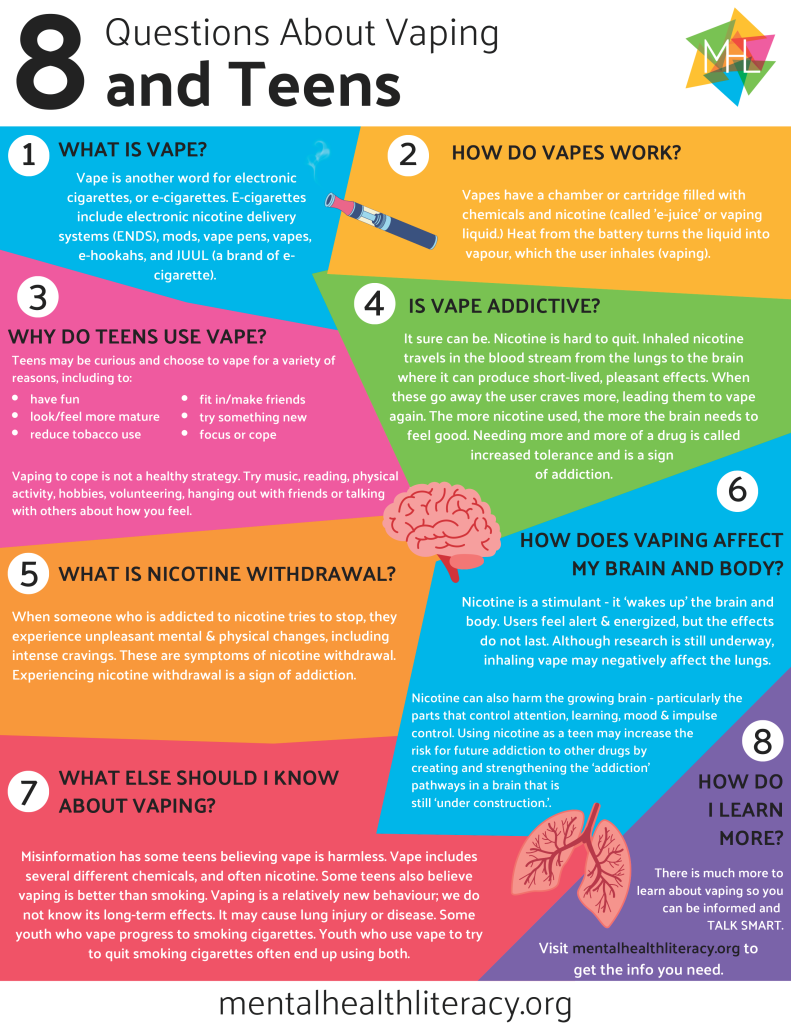N icotine is the chemical in tobacco that makes it hard to quit. Nicotine produces pleasing effects in the brain, but because these effects are temporary, users are left wanting more. Nicotine can come in many forms:
- Electronic cigarettes are a newer way to use nicotine and are quickly becoming the most popular form of use. Electronic cigarettes (e-cigarettes) include electronic nicotine delivery systems (ENDS), mods, vape pens, vapes, e-hookahs and JUUL (a brand of e-cigarette). They are battery-operated devices that have a chamber filled with nicotine and other chemicals. The heat from the battery turns the chemicals into a vapour, which is inhaled by the user (this is called ‘vaping’).
- Hookah pipes are used to smoke wet tobacco (tobacco mixed with drops of water) or sometimes tobacco mixed with glycerin and/or honey. As hookah has become more commercialized, flavouring is often added to make it even more appealing.
- Cigarettes use finely cut tobacco leaves that are rolled in thin paper
- Chewing Tobacco uses shredded or twisted tobacco leaves
- Cigars use whole tobacco leaves
Nicotine use among youth is concerning for several reasons:
- It can harm the developing brain, namely the parts of the brain that control attention, learning, mood and impulse control. Brain development continues into the mid-20s.
- Using nicotine in adolescence may also increase risk for future addiction to other drugs
- Youth who mix tobacco with cannabis may have a harder time stopping smoking; the combination may make withdrawal symptoms stronger
Nicotine dependence occurs when someone ‘needs’ nicotine and struggles to stop using it. The more a person smokes, the more nicotine they need to feel good. When they try to stop, they experience unpleasant mental and physical changes. These are symptoms of nicotine withdrawal.
According to the Canadian Student Tobacco, Alcohol and Drugs Survey (CSTADS) 2021-2022, 17% of students in grades 7 to 12 (357,000) had ever tried at least one of the following tobacco products: cigarettes, cigars or little cigars/cigarillos, heated tobacco products, smokeless tobacco and water pipes.
Young people who use e-cigarettes may be more likely to smoke cigarettes in the future.
The best way to find out if a young person is vaping or smoking is to have an open conversation. If a youth is smoking cigarettes, you’ll likely be able to smell it. Detecting vaping can be a bit more difficult—but there are still some potential signs of use:
- Devices: E-cigarettes or ‘vape pens’ can look like a USB drive, pen, or stylus, with holes on each end
- Sweet smells: Vapor juice is often flavored, so if you suddenly smell fruit punch or bubble gum (and there’s no candy around) it could be a red flag
- Nosebleeds: Vaping can dry out the nasal passages and cause nose bleeds
- Drinking more liquids: The vaporized liquid in e-cigarettes contains propylene glycol, which attracts and holds water molecules from the mouth, which may cause dry mouth
Nicotine Legislation:
In Canada, it is illegal to sell or provide vaping products to anyone under 18. There are also federal regulations in place that prohibit the advertisement of vaping products towards, and around, youth. These regulations extend to ads in public spaces where they can be seen or heard by youth (e.g., in stores, online or some media channels).
Sources
- Canadian Student Tobacco, Alcohol and Drug Survey (CSTADS) 2021-2022. Summary of Results: https://www.canada.ca/en/health-canada/services/canadian-student-tobacco-alcohol-drugs-survey/2021-2022-summary.html
- Canadian Paediatric Society: Protecting children and adolescents against the risks of vaping (2021): https://cps.ca/en/documents/position/protecting-children-and-adolescents-against-the-risks-of-vaping
- My Health Alberta: Using cannabis and tobacco together (2020): https://myhealth.alberta.ca/Alberta/Pages/Using-cannabis-and-tobacco-together.aspx
- Chatterjee, K., Alzghoul, B., Innabi, A. and Meena, N. (2016). Is vaping a gateway to smoking: a review of the longitudinal studies. Int. Journal of Adolescent Medical Health, 9:30 (3): https://pubmed.ncbi.nlm.nih.gov/27505084/
- Goldenson, N.I., Leventhal, AM, Stone, MD, McConnell, RS, and Barrington-Trimis, JL. (2018). Associations of electronic cigarette nicotine concentration with subsequent cigarette smoking and vaping levels in adolescents. JAMA Pediatrics, Vol.171(12): https://pubmed.ncbi.nlm.nih.gov/29059261/
- Lanza, H.I. and Teeter, H. (2018). Electronic nicotine delivery systems (E-cigarette/Vape) use and co-occurring health-risk behaviors among an ethnically diverse sample of young adults. Substance Use & Misuse, Vol.53 (1): https://pubmed.ncbi.nlm.nih.gov/28777675/


